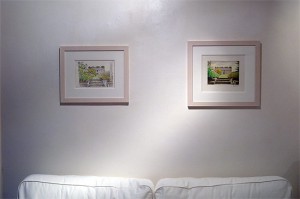ERIK BULATOV
6 October - 10 December 2011Erik Bulatov has studied and worked in Moscow until the end of the 80’s. Graduated from the prestigious Institut of art Surikov in 1958, he then worked as an illustrator for children’s books while pursuing his research and reflection about his pictorial activity.
In the 60’s he is already a major figure of the non official art, as the leader of the Russian conceptual art. As numerous other artists, Bulatov left Russia in 1989 and moved first to New York and then to Paris where he settles for good in 1991. His works, thanks to the Perestroika, acquires an unprecedented visibility. His first major solo show takes place at the Centre Pompidou in 1988, after having been presented at the Kunsthalle in Zurich. Before then, the opportunity of exhibiting was extremely rare. In 1977 some of his paintings were presented at the Venice Biennale, nonetheless his works was not known in Russia outside the restricted circle of the non official art. Today his works are in the most important European and American museums as well as in private collections. Nowadays he is officially recognized in his mother country where, from 2008, he has become Honorable Member of the Russian Academy of Arts.
In occasion of his new show at the gallery, Erik Bulatov has created an important painting intended for the space of the GALERIE PIECE UNIQUE. This great canvas, “ Une Grange en Normandie”(A Barn in Normandy) is composed of two parts representing the same landscape. The higher part seems a daytime sight whereas the lower one looks like a night vision, thus as a negative of the first. The complex composition slowly invites us to detach from the subject represented in order to truly feel the spatiality of the canvas.
At PIECE UNIQUE VARIATIONS a series of paintings is presented together with some landscape drawings. These works, in which the artist’s technical ability contributes to strengthen the system of spatial construction, are characteristic of his artistic approach; one feels the heritage of the Russian avant-garde, suprematism and constructivism, as well as that of the traditional Russian landscape paintings.









